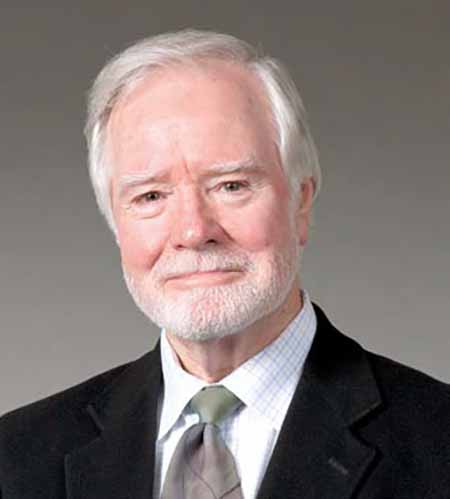The Sharper Image(r)

Tom Butts
Editor-in-Chief
tbutts@nbmedia.com
When you visit a movie theater or watch a television show today, the imaging technology behind what you’re seeing is the result of the coordinated efforts of some of the brightest minds in our industry. But few have been more influential in the development of that advanced imaging technology than Laurence J. Thorpe.
Larry is being honored this year with the Charles F. Jenkins Lifetime Achievement Award by the Television Academy, which he will receive during the 66th Primetime Engineering Awards in Las Vegas next month. I had a chance to talk with Larry recently; he discussed his career and shared his thoughts on the development of television technology.
Larry’s career spans more than five decades. After graduating with a degree in electrical engineering from the University of Dublin, he began his professional career with the BBC, helping to design studio equipment. After that, he moved to the United States, where he joined RCA to develop camera technology, which was new to him at the time.
“That was in 1966 and I’ve been associated with cameras in one way or another ever since then,” Larry said. “I’ve never lost my love for imaging, cameras, lenses and all of that.”
Sixteen years later, Larry joined the newly formed Sony broadcast group and became one of the earliest evangelists of digital imaging technology during the 1980’s, a role that sometimes ruffled a few feathers with Hollywood, with one noted cinematographer dubbing him the “great white Satan” of digital.
For the record, Larry makes it clear that he never said “film is dead.”
Get the TV Tech Newsletter
The professional video industry's #1 source for news, trends and product and tech information. Sign up below.

“I always said that motion picture film is the yardstick and video has a long way to go to match that image quality,” he said. At the time, “it was almost heresy to dare to offer digital equipment to replace or be an alternative to motion picture film, which was very much loved,” Larry said, adding that he considers his role in the development of digital cinematography to be among his proudest achievements. “Today we see digital rapidly replacing motion picture film… I would say that we’re better than film, especially in the era of 4K, which is significantly beyond the capabilities of 35mm on a screen.”
Larry’s role at Sony prompted him to become one of the earliest proponents of HDTV, which gives him a unique perspective on the rollout, a transition he describes as “disjointed,” due to the lack of coordination among various industry segments.
In the early days of television, standardization was fairly straightforward, according to Larry. “Back then, you would work on your standards basically as a SMPTE standard,” he said. “But Hollywood climbed in because they were watching this very warily and they said, ‘We’ve got to be a part of this,’ and then the computer industry jumped in, then the Department of Defense jumped in. Suddenly the standardization committees were all these bodies, each with a different agenda and it became very strenuous, painful and stretched out for years.
“The other aspect was that companies like Sony and Panasonic, who had led the charge with high-definition production equipment… the consumer arms of those companies were nowhere in sync,” he said. “It was 10 years later before the consumer elements said, ‘Oh, I see, this HD is hot, we better do something.’” So we had that terrible disjoint between production and the receiver end.”
The current transition to 4K is in better shape, Larry says. “With 4K, you have a synchronism with the consumer electronics industry driving hard 4K while all of us manufacturers are driving fairly hard on cameras, lenses, recorders, etc. to make 4K,” he said. “I think [the market acceptance of] 4K is going to move a bit faster than HD did. It took about 15 years for HD to gain any sort of recognition and reality.”
Larry is celebrating his 10th anniversary with Canon where he is the Senior Fellow and played a major part in the introduction of the company’s line of award-winning digital cinema cameras. It’s a testament to his influential role in this industry that he is being recognized for his work, even if the recognition is over due. But when I asked him to name the biggest surprise of his career, he didn’t shy away from the fact that he was an early skeptic of digital.
“I remember at RCA, in one of my more mature years when digital was just looming, it was like the end of history and we were talking very gloomily amongst ourselves that there was nothing exciting left in television,” he said. “Suddenly the Quantels of this world appeared and suddenly this magic of digital just started to bubble and it just blew and just permeated and that really ignited all sorts of capabilities in television.”
Congratulations Larry! Thanks to you, the big (and small) pictures are quite a bit sharper today.
Tom has covered the broadcast technology market for the past 25 years, including three years handling member communications for the National Association of Broadcasters followed by a year as editor of Video Technology News and DTV Business executive newsletters for Phillips Publishing. In 1999 he launched digitalbroadcasting.com for internet B2B portal Verticalnet. He is also a charter member of the CTA's Academy of Digital TV Pioneers. Since 2001, he has been editor-in-chief of TV Tech (www.tvtech.com), the leading source of news and information on broadcast and related media technology and is a frequent contributor and moderator to the brand’s Tech Leadership events.

